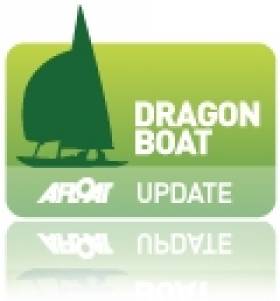Displaying items by tag: RStGYC
#dragon – The weekend's Cannonball Trophy saield on Dublin Bay is an annual team racing event sailed by Dragon sailors from The Royal London Yacht Club in Cowes, The Royal Netherlands Yacht Club in Muidan Holland and The Royal St George Yacht Club in Dun Laoghaire. Occasionally the Dragon sailors from Deauville Yacht Club in France also compete but they were unavailable to travel this year.
Racing is held on a Friday & Saturday in April.
This year they sailed in glorious conditions on Friday in Scotsmans Bay with about 10knots of breeze. We used an equalised fleet of 1720's from three of the waterfront Clubs in Dun Laoghaire for the event. Two Rounds were sailed on Friday where the London Dragons ended up with just one extra race win ahead of the Dublin Bay Dragon Fleet. The fleet were expected to go into a five race final against each other on Saturday but this was not to happen as the Race Officer deemed the 20–knot conditions to be unsafe for racing.
The event is as much about the socials as it is about racing. The sailors were treated to a night of traditional Irish entertainment in Johnny Fox's Pub in the Dublin mountains on Friday evening. On Saturday after racing was cancelled they headed on the DART to Howth for a long lunch in Aqua Restaurant before returning to the Royal St George for a dinner & prize giving.
The Dublin Bay Dragon helms were: Martin Byrne, Andrew Craig & Tim Pearson.
Royal Cork's McCann & Walsh Win 420 Nationals Trophy at RStGYC
#420sailing – After nine great races on Dublin Bay, Royal Cork Yacht Club's Peter McCann and Arran Walsh claimed the 420 Nationals trophy last weekend writes Clodagh Lyttle. The teenagers sailed to victory in style, winning four races over the three day event hosted by the Royal St. George Yacht Club. 15 boats competed and seven of these were girls pairings. The fleet, aged between 14 and 18 enjoyed the courses set by PRO Richard Kissane. Full results downloadable below as a jpg file.
This result means that there are two homes in Crosshaven who have two National Champions in the family. Last week James McCann, Peter's brother won the Optimist Trophy and earlier this year Nick Walsh, Arran's dad won the Laser Masters Trophy.
McCann and Walsh managed to defeat the ISAF pair Robert Dickson and Sean Waddilove who were 20th in the World Championships in Germany. Similarly Cliodhna Ni Shuillebhain and Jill McGinley won the Ladies Title overcoming Lizzie McDowell and Cara McDowell who came 16th in the ISAFs. The standard of sailing in the Irish 420 fleet is extremely high, as another pair Harry Whitaker and Grattan Roberts also had a great result when they came 20th at the Junior Europeans .
After the prizegiving, 420 coach Ross Killian, Arran Walsh and Bill Staunton took the ice bucket challenge, much to everyone's enjoyment. The 420 sailors prepared two huge wheelbarrows of iced water and poured it on their coach.
The next 420 event is the Leinsters in Wexford Harbour on 13th and 14th September.
#rsgyc – As part of this weekend's Frank Keane BMW Royal St. George Yacht Club regatta, the club is staging a White Sails & Non-Spinnaker team challenge event.
The reasons behind the initiative is to encourage a sociable, time friendly, event with a mixture of competitive and fun sailing. As previously reported by Afloat.ie The emphasis, say organisers, is as much on the activities ashore as well as those on the water.
Dun Laoghaire could be described as the home of White sails racing in Ireland. Trevor Wood a member of the RSGYC and, then Beneteau Oceanis 411 owner, had in 2002, come up with the concept of regular fleet racing in Dublin Bay within the DBSC series. The idea was not just to provide racing for boats that could be more properly described as cruising or family boats than racers, but to enjoy meeting and eating in the Clubs afterwards.
The Dublin Bay White sails fleet rapidly grew into one of the strongest classes in the Bay with consistent Thursday evening turnouts of over twenty boats, though with numbers dropping off a little as thoughts turn to cruising. The White Sails fleet also makes up about a quarter of the DBSC Turkey Shoot and Spring Chicken fleets.
For Regattas and other open events the White sail Class races as a separate division within the Non-Spinnaker fleet, thus giving the, essentially cruising boats a chance to collect some silverware.
Over the years the Class has run a number of non-racing events, trips to Greystones etc. and this year approached the RSGYC to put into place a new event running over three days of very varied racing and socialising linked in with the Club Regatta. This event would be more than one for local boats but an opportunity to sail and enjoy the company of Non-Spinnaker sailors from elsewhere as well.
The Royal St. George YC took on the event with enthusiasm. It fits well within the active programme there of broadening sailing opportunities in Dun Laoghaire and has proposed running the Challenge alongside future Club regattas.
In order to make the challenge more fun and "different" it will be based on a club team basis with the best scores of the top three boats representing each Club counting towards the prize. Over the years inter-Club rivalry is expected to become more intense and with it, a strong growth of White sail and non-Spinnaker racing.
More details on the event from Howard Knott on +353 86 810 3025.
#rsgyc –One novel addition to this weekend's Royal St George Frank Keane BMW George Regatta, one of the biggest club regattas of the year, is the "Try Sailing" initiative which allows non sailors, family members or first timers to get out on the water in the Club 1720s. Life jackets will be provided and the idea is that it should be a fun half hour or so in a sailing boat with a qualified Club instructor in charge.
In addition the RSGYC White Sails & Non–Spinnaker Team Challenge is a new event run over three days to include the racing in the Regatta on Saturday. See details downloadable below. This is an event designed by the White Sails Class to encourage a sociable, time friendly, event with a mixture of competitive and fun sailing. Emphasis is as much on the activities ashore as well as those on the water.
Posters for the TWO events happening in RSGYC this weekend are downloadable below as PDF files.
#rsgyc – The RStGYC May/June Friday Series (open to all comers) for Laser and RS dinghies had another two great races last night writes Heather King. Good to see the increased turnout and we were lucky with a little ridge of higher pressure between a series of lows and by start time the breeze had eased all the way back to a very pleasant 10 knots, blowing out from the direction of Seapoint's Martello Tower.
#rstgyc – Races were rattled off by surely one of the youngest Race Officers Dun Laoghaire has ever seen for adult racing. Adam Hyland, who has represented the George overseas with distinction and topped national rankings in both the 420 and Optimist classes, performed one master-stroke in particular. He noticed he had time pre-start to shift his freshly-laid course 200 yards offshore. He saw fresher breeze and, crucially, big flicks to the left and, had he not relaid, the weather mark would have required a position way South, which would have been a very interesting obstacle course over the West pier !
RSs went off first for 3 rounds W/L and at the first mark the Boys Craig/Foley led in a 200 from Ryan/Murphy in the 400. However, Emmet and Luke in the bigger rig soon showed great speed and downwind angles, allied to slick boathandling, to dominate both races for the rest of the night. Craig/Foley led the 200s home comfortably in race one but were further back in the two lap second race when Clodagh and Adrian Hinkson staged a remarkable comeback on the lead 200 raced by Laser/Fireball ace Justin Maguire. The Hinksons carried a beautiful, soaking downwind course in a softening breeze and, had they not required one final gybe just a few metres from the line, they would surely have pipped Maguire and crew Heather Craig. Downwind finishes sure are interesting !! The other 200 and 400 crews all had their moments in the challenging patchy, shifty conditions.
The Lasers sailed two rounds each time and it was good to see some additional new faces this week in Ross O'Leary, Conor O'Leary and Peter Docherty. Things were competitive, especially when Ross challenged in race One and Conor got well in the mix in race Two. However Patrick Cahill again showed apalling disrespect for his elders, claiming both guns ! This Radial sailor will have no problems at all with the Full rig going forward, that much is clear. It also shows this Friday series is absolutely perfect for younger sailors anywhere close to the transition stage between the smaller Laser rig and the Full. Plus what better way to take a little break from studies on a Friday night ?
Hyland wrapped things up to give his two old sea dog assistants a rest onboard the flagship and things looked decidedly gloomy and dark for 8 o'clock. Sure enough the heavens later opened up but boats were all derigged and pints and burgers were already being guzzled down under cover on the balcony.
We'll welcome more next week for sure as 4 or 5 cyclists were absent, not on the visting Giro D'Italia but away terrifying people with their lycra on the island of Mallorca. Lads, please note the lycra is out on this racetrack, especially "Giro pink". The peloton will no doubt also be boosted by the returning Hugh Sheehy. Expect double figure turnouts in both RSs and Lasers.
Regatta entry here
Minister of Sport Appoints Royal St. George Vice–Commodore to Dun Laoghaire Harbour Company Board
#dlhc – Royal St. George Yacht Club vice–commodore Justin McKenna has been appointed to the Board of Dun Laoghaire Harbour Company. Well known yachtsman McKenna is a former chairman of the Dun Laoghaire Comnied Yacht Clubs and the current vice–chairman of the country's biggest yacht club, the Royal St. George that occupies a key location within the harbour on Dun Laoghaire's waterfront. He joins two new Board members appointed to the Board by the Minister for Transport, Tourism and Sport, Leo Varadkar TD and come into effect immediately.
The appointments are:
· Mark Finan who is a barrister-at-law with particular expertise in regulatory compliance, European and international law. He lives in Monkstown, Co Dublin.
· Justin McKenna who is a solicitor at the Dún Laoghaire-based solicitor practice, Partners at Law.
· James Jordan is a retired SIPTU trade union official and continues to be a community activist in the Dún Laoghaire area. He lives in Glenageary, Co Dublin.
The Board of Dún Laoghaire Harbour Company now comprises eight members, which is the maximum membership it can have.Speaking on the appointments, Chairperson of Dún Laoghaire Harbour Company, Eithne Scott Lennon said: "The appointment of three additional members to the Board of the Harbour Company by the Minister for Transport, Tourism and Sport, Leo Varadkar, gives us greater strength as we move into one of the most active development phases in the Harbour's history. "Following on from the Harbour Company's development plan, we are now embarking on the execution of some major infrastructural projects which will – I believe – position Dún Laoghaire as the primary leisure port facility in Ireland."
Plans include the delivery of an International Diaspora Centre on the historic Carlisle Pier, a deep cruise berth facility and a new mixed use housing and retail development. A number of initiatives to add to the leisure offerings at the Harbour have already been instigated, including the Urban Beach project, the Shackleton Exhibition and the new drive-in movie initiative which will commence later this month.
A key area of development for the Harbour Company has been the increase in cruise-calls to Dún Laoghaire in recent years, and we expect to deliver 100,000 leisure visitors and crew to Dún Laoghaire and its hinterland in 2015
Royal St. George Celebrate 175 Years of Champions
#rstgyc – A full club house of 250 sailors raised their glasses to a roll call of 175 years of sailing achievements at the Royal St. George Yacht Club this evening in Dun Laoghaire as Ireland's biggest yacht club toasted over 600 international titles. See photos below.
The champions were saluted by international yachting writers and guests of honour Bob Fisher and Afloat.ie's WM Nixon who gave a history of the Royal St. George Yacht Club achievements and a presentation on the very latest from the Americ's Cup.
The awards shared by 255 members include 322 Irish National Champions. Tonight's champion's dinner included 10 Olympians, the club has been represented at all Olympic Games but four since the first Irish participation in 1948. Ireland's only Olympic sailing medallist, Silver medallist David Wilkins from Moscow 1980, was also in attendance.
Royal St. George sailors have also won the Irish Helmsman Champions 30 times with 19 champions.
14 attended tonight's dinner. Round the World Racers Angela Heath & Damian Foxall). In Cruising, awards include circumnavigators of the globe Peyer and Susan Gray and Pete Hogan.
Epic Passages by Paddy Barry and Michael Holland and many transatlantic/transarc passages were also saluted.

Members of the Royal St George Yacht Club who have won the ISA Helmsmans Championship Back Row (l to r): Robin Hennessey, Vincent Delaney, Johnny Ross-Murphy, Brian Craig, Peter Bayly Front Row (l to r): Neil Hegarty, Sean Craig, Tom FitzPatrick, Adrian Bell, Stephan Hyde, Gerald 'Gerbil' Owens, Chris Arrowsmith, Matthew O'Dowd, Commodore Liam O'Rourke. Photo: Gareth Craig

Members of the Royal St George Yacht Club who have represented Ireland in the Olympic Regatta Back Row (l to r): Peter Grey, Robin Hennessy, David Wilkins, Commodore Liam O'Rourke Front Row (l to r) Barry O'Niell, Tom FitzPatrick, Derek Jago, Gerald 'Gerbil' Owens Photo: Gareth Craig
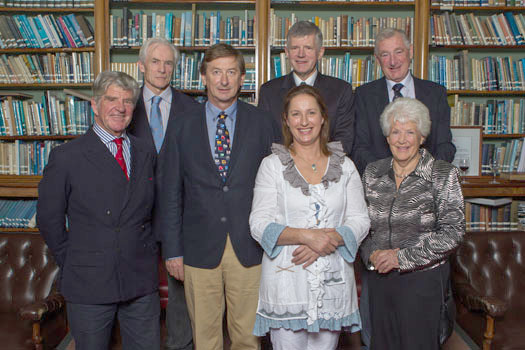
Members of the Royal St George Yacht Club who have circumnavigated the globe, or undertaken other significant cruising achievements: Back Row (l to r) Peter Hogan, Rod Cudmore, Peter Grey Front Row (l to r) Keith Hunt, Michael Holand, Angela Heath, Susan Grey, Commodore Liam O'Rourke Photo: Gareth Craig
All Sailing Super Stars, By George
#rsgyc – The word on the grapevine is that the Royal St George Yacht Club, currently the Mitsubishi Motors "Sailing Club of the Year", is planning a special festive event to celebrate its 175th birthday. The whisper is that it will be a gathering to honour those members who have won major events and titles right up to and including Olympic medals.
We've been allowed a glimpse of the list, and it's very impressive. Which is what you'd expect from a club which has shown an extraordinary ability to adapt successfully to changing circumstances, while displaying a special talent for recruiting promising sailors from all round the country when they come to Dublin, either to go to college or to work.
Yet even as they keep a weather eye open for potential members who will give as much to the club as it will give to them, the club's administrators never lose sight of their past. And what a past it has been. Like many great clubs, it started modestly enough around 1838 as the Pembroke Rowing Club in south Dublin. But the oarsmen of the Dodder soon reckoned that the cleaner waters of the new harbour out on Dublin Bay, where Dunleary had recently been re-named Kingstown, would provide more pleasant conditions than the fetid Liffey.
As for their sport, several key members were thinking of moving into slightly larger craft, driven by sail. Suddenly, the new club took off. Boat sizes and numbers increased exponentially, the membership became rather grand and extremely wealthy, and by the 1850s the little rowing club had morphed into the Royal St George Yacht Club, with handsome and frequently extended premises on the waterfront, and a membership list which seemed to include just about every great landowner in Ireland who had the slightest interest in the rapidly growing sport of yachting.
In looking back from the present day, we tend to think that the modern emphasis on active participation is just that – a modern thing. Indeed, it's said that it was a member of the George, when it was at the height of its affluence, who occasioned the apocryphal story which captures the sprit of certain yacht owners at a time when most wealth was concentrated in very few hands. Cue to stately home somewhere in Ireland:
The Butler waits upon his lordship, and clears his throat in a meaningful manner.
His Lordship: "Yes, James".
Butler: "My Lord, I have just been in conversation with our land agent".
HL: "Indeed".
Butler: "And he tells me that we are living in financially stringent times".
HL: "Is that so?"
Butler: "Such seems to be the case, my Lord. In fact, the agent tells me that we may have to implement some cutbacks in the usual expenditure".
HL: "Nothing too severe, I trust".
Butler: "Well, my lord, I'm afraid the agent thinks that we may have to sell the yacht"
HL: "Sell the yacht?"
Butler: "Regrettably so, my Lord".
HL " Good heavens. D'you know what, James? I didn't know we had a yacht. Well, I do declare. Isn't life just full of surprises? I'll need to think about this".
But while there were George members who shaded towards this approach to yachting, there were others who really did sail the seas. One of the original Pembroke men, William Potts, had moved up from rowing to serious seagoing with the substantial new cutter Caprice, and in 1850 he cruised to Iceland.
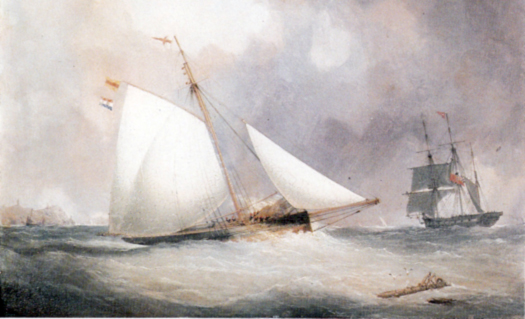
The cutter Caprice in which William Potts, a founder member of the Royal St George YC in 1838, cruised to Iceland in 1850.
As for the racing side of things, we have to remember that this was still in its infancy in terms of organisation even if Lough Erne YC had been formed in Fermanagh as long ago as 1820 specifically to run yacht races, and thus records of early sailing events are often incomplete and inconclusive. After all, the George had already been in existence for a dozen years when the schooner America won that famous race round the Isle of Wight in 1851, but the fact that it was a scratch event which took no account whatever of different yacht sizes in collating results shows indicates the relatively primitive site of the sport of yacht racing at the time.
But the rapid increase in wealth in the latter half of the 19th century meant that the development of yachting, and its regulation, accelerated markedly. In Ireland, it was in Belfast that economic growth became most rapid, and the new wealth accumulators from the north were keen to get involved. The Ulster Yacht Club did not get founded until 1866, and it became the Royal Ulster YC in 1869. But meanwhile one of the richest and most energetic of the new Belfast linen magnates, John Mulholland who later became Lord Dunleath in 1892, had been spreading his sailing wings as a member of the Royal St George.
By the 1860s, schooner racing was the apex of the sport, and in 1865 Mulholland commissioned the 153-ton schooner Egeria from the top designer-builder of the time, Wanhill of Poole. At just under 100ft LOA, the beautiful new vessel soon became known as "the wonderful Egeria", and for more than a decade she was the winner par excellence with more than sixty major trophies to her credit, while her owner was so fond of the boat that he kept her for many years after she had been out-classed as a racer.
In Egeria's competitive years, Mulholland was no absentee yacht owner. On the contrary, he seems to have been the Denis Doyle, the Piet Vroon, of his day, enthusiastically racing his lovely ship with a crew of 12 wherever there was good competition to be had. He embodied the best of the sporting instincts among the active yacht owners in the George, which had been a leading club in supporting the idea of "flying starts".
This marked a change from the early days of yacht racing, where the starting gun was fired with all competitors lying to their anchors. A flying start under full sail across an imaginary line was much more fun, and in Dun Laoghaire harbour it could be extremely sporty when the big yachts got crowded. As for the finishes, they were recorded by the naval officer/marine artist Richard Brydges Beechey, so we have a fair idea of what they could be like, but the image is augmented by an account of "the famous Egeria" making an in-harbour finish under full sail to win: "....what a fright the Egeria gave the multitude of yachts lying at their moorings when, on returning to Kingstown harbour she, on rounding the buoy, had so much way on that she absolutely ran through the crowd of yachts. The escape of many craft was little short of marvellous...."

A cutter finishing in the harbour at the Royal St George Regatta, 1871, as recorded by Richard Brydges Beechey. The larger schooner at anchor on left may be Egeria
By the time Beechey was recording the scene, cutters had taken over from schooners as the premier racing class, but here too the Royal St George was to set the pace with John Jameson and his legendary Irex. The Jameson family had been moderately prosperous whiskey distillers in Dublin since 1780, but in 1864 phylloxera wiped out the vines in the brandy districts of France. With brandy supplies dwindling, Irish whiskey and soda soon became such a fashionable drink internationally that the entire Jameson family entered the ranks of the mega-rich.

John Jameson's 1884-built cutter Irex was the most successful racing yacht of her era. She is seen here after winning the annual regatta of the Royal Harwich YC on England's east coast
John Jameson himself, while an extremely able businessman and talented sailor, was personally rather shy. However, his younger brother Willie was anything but, and the Jameson brothers with the 1884-built Irex were enthusiastic campaigners on all coasts with John the backroom boy, while Willie was front of house. And the fact that every time Irex won a regatta, the name John Jameson appeared in the newspapers was no harm at all for their whiskey sales. Then at Cowes Week after a spectacular race in heavy weather in which the Irex won by half a boatslength, as the brothers were anchoring afterwards, the rowing gig from the royal yacht arrived alongside and a written message was passed on board: "The Prince of Wales compliments and congratulations. His Royal Highness would be very pleased if Mr Jameson could join him for drinks before dinner".
John Jameson became hyper-shy, and said to Willie he couldn't be dealing with a situation like that at all. But Willie said not to worry, he was Mr Jameson too. So off he went to the party and got on so well he stayed to dinner. And when the Prince of Wales was planning the building of the superb Watson cutter Britannia a few years later, he asked Willie to be owner's representative during the building and commissioning, and subsequent racing.

The day Britannia came to call. The new royal cutter Britannia in Dun Laoghaire harbour in 1893 on her delivery voyage from the Clyde to the Solent, "and Mr Willie Jameson was seen on board". Note that a boomless gaff trisail is set instead of the full main.
Needless to say, nobody really believed it back in Dublin, so when the brand new Britannia was being sailed south to the Solent from the Clyde in 1893, Willie Jameson made damned sure she called to Dublin Bay, and the local papers duly reported that "Mr Willie Jameson was indeed seen on board". But while he was a great man for a party, Willie could be cussed enough. When the Britannia was being scuttled in 1936 in accordance with the recently-deceased George V's will, the Royal Family sent Willie Jameson her steering wheel as a memento of his time on board in a key role. But he promptly sent it back with a curt note saying that when he sailed the Britannia, she was tiller steered....
The Jameson standing in sailing was such that when Lord Dunraven decided it was time he took up sailing in the mid-1880s, it was as a member of the Royal St George and aboard Irex that he got his first taste of the sport, an experience which followed with his two increasingly acrimonious America's Cup challenges in the 1890s which, mercifully for the George, were made through the Royal Yacht Squadron to which the County Limerick peer had transferred his allegiances.
Back in Dublin Bay meanwhile, it was a very active and successful Royal St George sailing member, wine merchant George Black Thompson, who was one of the sailing men involved in codifying yacht racing through the Royal Alfred YC's pioneering work. But G B Thompson was primarily a George man, and just as it is with the club nowadays, he was keen to encourage promising newcomers. Thus in 1892 when his 5 Rater Shulah was becoming out-classed competitively but had the ability to become a fast cruiser, he was more than happy to sell her to two young brothers who had been teaching themselves to sail with a Water Wag dinghy up on Lough Dan in the Wicklow mountains, and now wanted to cruise.

G B Thompson, a leading member of the Royal St George YC for many years, introduced Erskine Childers to the possibilities of cruising in 1892. He succeeded Lord Dunleath as Vice Commodore in 1895.
Shulah's new owners were Erskine and Henry Childers. They soon took Shulah away from Dublin Bay with a cruise to the west of Scotland, where they laid the boat up and cruised the Hebrides again the following summer. After that, Erskine Childers began his career in London. He decided Shulah was too deep for his new cruising area in the Thames Estuary, and acquired the Vixen which, after a cruise to the Friesian islands and the Baltic, became the fictional Dulcibella, "heroine" of his best-seller novel Riddle of the Sands.
Published in 1903, the Riddle of the Sands hinted at the possibility of war between Germany and Britain, which duly came in 1914. But at the same time many of the Royal St George members were facing their own problems with the breaking up of Ireland's largest estates under the Land Acts. That and the Easter Rising of 1916 and the establishment of the Irish Fee State in 1922 meant that in the space of just three decades, the club had gone from affluence to a relatively sparse existence.
Yet somehow it adapted, and in time the club was back in the forefront of sailing in an Ireland which may have seemed changed. But was it really? As a member of the new Free State Government put it, "we are the most conservative revolutionaries ever seen". So, far from the relics of ould decency like the old royal yacht clubs being wiped out, in time they began to thrive again, and by the mid-1930s the George was extending its forecourt to accommodate sailing dinghies such as the Water Wags, while members also were involved in forming the new 17ft Mermaid class
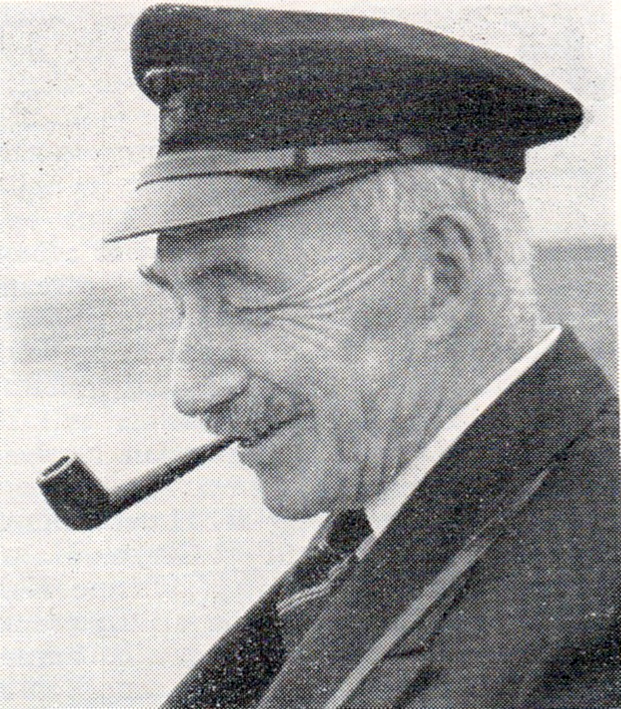
Billy Mooney, who had sailed from Howth between 1919 and 1943, then moved to live in Sandycove and became very active in the Royal St George, of which he had already been a member for many years. A founder member of the Irish Cruising Club, he is seen here at the age of 74 when he was still to be seen sailing as a member of the George squad in Firefly Team racing, another area of sailing in which the club played a pioneering role.
As World War II ended in 1945 and international sailing resumed, the club was right in there, with a leading member, Billy Mooney, winning his class in the 1947 Fastnet with his 43ft ketch Aideen. The Mooney family – Billy and his son Jimmy - were a formidable force in sailing, and were also in the forefront of the establishment of the Irish Dinghy Racing Association. It was a fellow dinghy enthusiast, Douglas Heard, who was to become the first "commoner" to be Commodore of the Royal St George, succeeding the Earl of Iveagh, one of the Guinness family, in 1960.
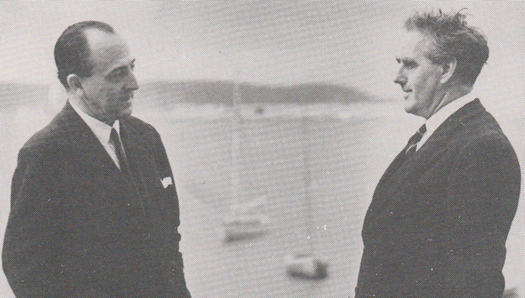
Douglas Heard (left) and designer Uffa Fox discussing the new Huff of Arklow on the club veranda in 1950

Well ahead of her time. Douglas Heard's Flying Thirty Huff of Arklow, designed by Uffa Fox and built by Jack Tyrrell, incorporated design features which were not generally adopted in offshore racing boats for another thirty-five years. Photo: W M Nixon
There was of course nothing common about Douglas Heard, who somehow found time to record the Irish sailing and boating scene on film while at the same time being an active participant, as his interests encompassed just about every branch of sea sailing, while his passions included the preservation and restoration of Ireland's inland waterways. Offshore racing and distance cruising were among his activities, and in 1950 he had his friend the innovative designer Uffa Fox create the plans for a Flying Thirty racer/cruiser. In effect a double size Flying Fifteen, this very advanced boat was built by Jack Tyrrell in Arklow, and though she was so far ahead of her time as to inevitably have weaknesses on some point of sailing, off the wind she was unbeatable while her seagoing credentials were amply demonstrated by cruises to Iceland and the Azores.

Three stages of development in the Royal St George YC premises. The clubhouse (right) in the 1880s. when there was much more in the way of green spaces on the Dun Laoghaire waterfront.......

.....and in 1934 shortly before the forecourt was extended to provide improved dinghy space and better access to deep water....

......and the Royal St George Yacht Club today, providing full facilities for all branches of sailing. Photo: David O'Brien
In compiling the first provisional list of the George's significant sailing award winners which currently goes back only to 1946, the organisers of the upcoming 175th Anniversary celebrations have produced 12 pages of data, many of them very tightly packed with names. The word is that this list will soon be available to members so that anyone who thinks that he or she (or an ancestor) has been overlooked can have their claims to inclusion considered. Outsiders seeing it may note names which are better known for their associations with other clubs, but the fact that they are George members, or were at the time of their achievement, is inescapable.
As it stands, it's a formidable data-base. You get the flavour of it by the listing of Olympic sailors. Since 1948, when Alf Delany and Hugh Allen raced in the Olympics two-handed class, members of the Royal St George YC have been involved more often than not, the only post World War II Olympics in which they haven't sailed for Ireland being 1956, 1968, 1984, and 2000, with the supreme achievement being the Silver Medal won by David Wilkins in 1980.
The Irish Helmsman's Championship has also been a happy hunting ground, with Douglas Heard winning an early staging in 1947 while the most recent was Tom Fitzpatrick in 1998 in a lineup of 16 winners. But such achievements are only the peaks of a broad swathe of success which has encompassed an extraordinary range of members and boats going right back to 1838. So it is timely that the club should be celebrating its own achievers in this the year of its 175th birthday, as the Club of the Year trophy was mainly in recognition of the Royal St George Yacht Club's achievement in staging the hnyper-successful Youth Worlds in 2012, and providing support and encouragement for the University College Dublin team as they underwent their rigorous buildup towards runaway success in the Student Yachting Worlds just eleven short months ago.
It will be quite a gathering, this cheering of the champions. All things considered, we can surely agree that the seagoing section of the Pembroke Rowing Club has done rather well.
#cluboftheyear – The Royal St. George Yacht Club in Dun Laoghaire was saluted last night with the Mitsubishi Motors Sailing Club of the Year award for its staging of last year's ISAF Youth Worlds, just one event in a packed 2012 season for the Dun Laoghaire waterfront club.
The presentation of the famous Ship's Wheel Trophy was made by Frank Keane, Chairman of Mitsubishi Motors Ireland to Royal St. George commodore, Liam O'Rourke in the Club.
Speaking at the Royal St. George, Frank Keane said, "Mitsubishi vehicles are often found in sailing surrounds, pulling boats of all shapes and sizes around the Country. So we have a great affinity with the sport and are delighted to be able to support it through our sponsorship of this award."
Last year's ISAF championship on Dublin Bay was described at the closing ceremony by ISAF's Fiona Kidd as truly the best ISAF Youth World Sailing Championship that she had ever attended".
Upon receiving the Ship's Wheel, Commodore O'Rourke said, "I am honoured to accept this distinguished award on behalf of the Club surrounded by members and friends of the Royal St. George."
To mark the achievement members and guests of the club gathered to celebrate the award which recognised an outstanding 12 months of success including the co-hosting of the ISAF Youths; an event that welcomed 350 sailors aged 14-19 years old from 63 nations, plus their coaches and team leaders to Dun Laoghaire for a week of world class competition and festivities.
The Royal St. George Yacht Club, which is celebrating its 175th anniversary this year, last won this award in 2010. This award was devised in 1979 to encourage and recognise the efforts of sailing clubs and associations nationwide.
#schoolsailing – 120 school children who participated in Dun Laoghaire's Sailing in the Community Programme were presented with their certificates of completion by Liam O'Rourke, Commodore Royal St George Yacht Club and Mr. Richard Shakespeare, Director Services, Dún Laoghaire-Rathdown County Council, at an awards reception in the Royal St George Yacht Club yesterday afternoon.
The Sailing in the Community Programme is a five year initiative by the Royal St George Yacht Club and Dun Laoghaire-Rathdown County Council to introduce primary school children to the sport. The aim being to teach children from the schools participating in the Dun Laoghaire-Rathdown After schools Fun Through Sports (DRAFTS) programme how to sail.
The purpose is to create a culture of sport and active recreation through sailing and foster a continued interest in sport.
The course was run from the Royal St George Yacht Club who partnered with the Irish National Sailing School to provide the participants with quality coaching, facilities and equipment. During the pilot scheme participants attended five weeks of coaching.
As part of the initiative twelve of the participants were awarded scholarships to the Royal St George Yacht Club Junior Sailing Courses this summer.
The participating schools were Holy Cross, St Joseph's, Our Lady's, St Kevin's, Dominican National School and St Colmcilles.
The winners of the coveted scholarships for 2013 were: Killian Kane & Lauren Maguire (Holy Cross), Erin McDonald & Vlarie Stirane (St Joseph's), Emma Murphy & Lyndsey Gregg (Our Lady's), Dan Connors & Chantelle Lee (St Kevin's), Curtis Clack & Kate McMullan (Dominican NS) and Dillon Mulligan & Sarah McDonald (St Colmcilles).
Speaking at the presentation of the awards Mr. Richard Shakespeare "congratulated all the participants on their achievements and welcomed the support of the schools and teachers for the DRAFTS programme. The project he said has been a great success; he was very pleased to be partnering with the Royal St George in this important initiative for the county and thanked all those involved in the organisation"



























